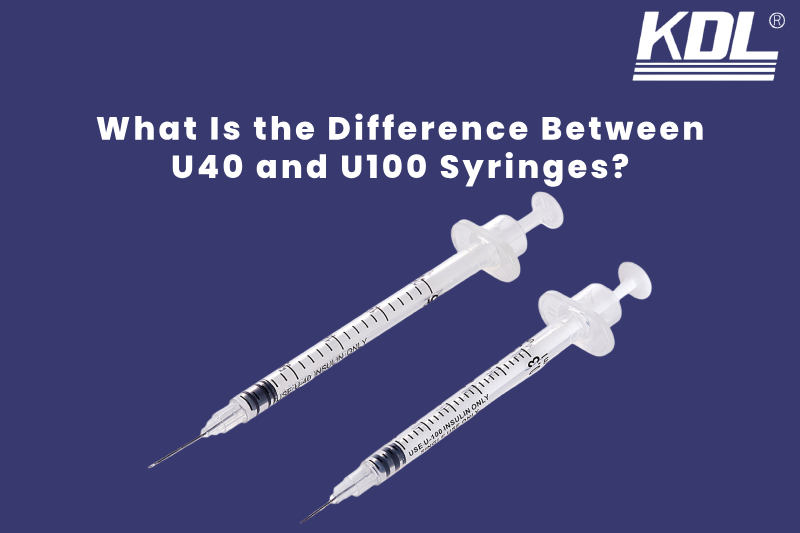
If you or your pet uses insulin, you’ve probably seen syringes labeled U40 or U100. These little numbers might look small, but they make a big difference. Understanding what they mean is one of the most important parts of giving insulin safely.
Whether you’re a pet owner giving insulin to your dog or cat, or you’re learning about human diabetes care, this guide will help you clearly understand the difference between U40 and U100 syringes — how they work, how to tell them apart, and why using the correct syringe matters.
Understanding What U40 and U100 Mean
Before diving into the differences, let’s break down what those labels mean.
The “U” stands for units of insulin per milliliter (mL) of liquid.
- U40 insulin means there are 40 units of insulin in 1 mL of fluid.
- U100 insulin means there are 100 units of insulin in 1 mL of fluid.
That’s more than double the concentration! So, U100 insulin is stronger than U40 insulin — it has more insulin packed into the same amount of liquid.
This difference in concentration is the reason why there are two different kinds of insulin syringes. Using the wrong one can lead to giving too much or too little insulin, which can be dangerous.
Why Insulin Syringes Come in Different Strengths
Insulin was originally made for humans, and over time, different strengths were created for different needs.
The History Behind U40 and U100 Insulin
Years ago, insulin came in several concentrations, which caused confusion. Eventually, U100 became the standard in human medicine in the United States and many other countries. Most insulin made for people today is U100.
However, veterinary insulin (the kind made for pets) often still uses U40 concentration. That’s because U40 insulin syringes allow for smaller, more precise doses — which are often needed for dogs and cats.
So, in simple terms:
- Humans usually use U100 insulin and U100 syringes.
- Pets often use U40 insulin and U40 syringes.
The Difference Between U40 and U100 Syringes
Let’s take a closer look at the key differences between these two types of syringes.
1. Insulin Strength
This is the biggest difference.
| Syringe Type | Insulin Strength | Units per mL |
|---|---|---|
| U40 | Less concentrated | 40 units/mL |
| U100 | More concentrated | 100 units/mL |
That means if you fill a U40 syringe and a U100 syringe both to the same mark (say, 0.5 mL), the U100 syringe would contain more than twice as much insulin.
2. Syringe Calibration and Markings
Each syringe is designed to match the insulin’s strength.
A U40 insulin syringe has markings that measure U40 insulin correctly. The same goes for U100 syringes, which are marked for U100 insulin.
If you mix them up, the markings won’t line up correctly — and you’ll either overdose or underdose the insulin.
For example:
- If you use a U100 syringe with U40 insulin, you’ll give less insulin than needed.
- If you use a U40 syringe with U100 insulin, you’ll give too much insulin — which can be very dangerous.
3. Color Coding
Most syringe brands use color to help you tell them apart quickly.
- U40 insulin syringes usually have red caps or markings.
- U100 insulin syringes often have orange caps or markings.
It’s still smart to always double-check the label before giving a dose — but this color coding helps prevent accidents.
4. Needle Size and Volume
Both U40 and U100 syringes come in a range of sizes (like 0.3 mL, 0.5 mL, or 1.0 mL), but the graduations (the little lines showing each unit) are spaced differently.
That means a 1-unit line on a U40 syringe represents a different amount of liquid than a 1-unit line on a U100 syringe.
That’s why you should always match the syringe type to the insulin concentration.
Why It’s Dangerous to Mix Them Up
If you use the wrong Syringe, it could really mess up your blood sugar. Let us check out what happens each time.
If You Use a U100 Syringe with U40 Insulin
Since U40 insulin is weaker, a U100 syringe will make you inject less insulin than needed. This can cause high blood sugar (hyperglycemia) because you didn’t get enough insulin to control your glucose levels.
For example:
- You draw up to the “10 units” mark on a U100 syringe.
- You only put in 4 units of insulin, though, since it’s U40 insulin.
Your blood sugar could rise quickly, leading to tiredness, thirst, and even diabetic complications.
If You Use a U40 Syringe with U100 Insulin
This situation is even more dangerous. You’ll inject too much insulin because U100 is more concentrated. That can cause low blood sugar (hypoglycemia), which can be life-threatening.
For example:
- You draw up to the “10 units” mark on a U40 syringe.
- But since it’s U100 insulin, you actually injected 25 units of insulin.
That’s over double what you intended! Severe hypoglycemia can cause confusion, shaking, sweating, or even unconsciousness.
How to Read Insulin Syringes Correctly
Reading insulin syringes can feel confusing at first, but once you know what to look for, it becomes simple.
Reading U100 Insulin Syringes
U100 syringes are calibrated for 100 units of insulin per mL. Common sizes include:
- 1 mL syringe (up to 100 units)
- 0.5 mL syringe (up to 50 units)
- 0.3 mL syringe (up to 30 units)
Each line on the syringe equals 1 unit of insulin. So if you draw up to the “10” mark, that’s 10 units of U100 insulin.
Reading U40 Insulin Syringes
U40 syringes are marked differently, since the insulin is weaker.
Each unit on the syringe still counts as one “unit,” but the amount of liquid in each unit is larger.
That means the physical spacing between lines is slightly different from U100 syringes — another reason why it’s vital not to mix them.
U40 vs U100 Insulin Syringes for Pets
U40 insulin is likely what you use to treat your dog or cat’s diabetes if you own one. These insulins are made just for pets, and because they are less concentrated, they can be given in small, exact amounts.
Here’s a safe and easy way to give insulin to your pet:
1. Always Use the Matching Syringe
If your doctor gives you U40 insulin, you should only use U40 syringes.
Make sure your vet gives you U100 syringes if you ever move to U100 syringes.
2. Store Supplies Separately
Insulin for a person in the same house should be clearly marked or kept separate from insulin and syringes for pets. This keeps things clear when things are rushed or in the morning.
3. Never “Convert” on Your Own
Some online sources show conversion charts for U40 and U100 syringes. While the math might seem straightforward, you should never attempt to convert or mix syringe types unless your veterinarian specifically tells you how.
A small dosing error can make a big difference for a small animal.
U40 vs U100 Syringes for Humans
For people with diabetes, nearly all modern insulins are U100 strength. This has become the global standard because it’s convenient and consistent.
However, in some countries or older treatments, you might occasionally see U40 insulin — though this is rare.
If you ever travel or move between countries, it’s important to check your insulin’s concentration carefully. Don’t assume all insulin is U100 everywhere.
Quick Reference: U40 vs U100 Syringes
| Feature | U40 Syringes | U100 Syringes |
|---|---|---|
| Insulin Strength | 40 units/mL | 100 units/mL |
| Used For | Pet insulin (dogs, cats) | Human insulin |
| Color Code | Red | Orange |
| Needle Options | 29G–31G | 29G–31G |
| Matching Requirement | Must be used with U40 insulin | Must be used with U100 insulin |
Tips to Stay Safe When Using Insulin Syringes
1. Always Double-Check Before Injecting
Check both the insulin vial and the syringe every time. Make it a routine: Check. Match. Inject.
2. Keep your supplies in order
Keep your U40 and U100 insulin syringes in different cases with labels on them. Do not put them in the same drawer or bag.
3. Always use a new syringe
Use insulin syringes only once. Needles that have been used more than once can get infections or become dull, which hurts more and can change how insulin is taken.
4. Learn how to measure correctly
Ask your doctor or diabetes nurse to show you how to use your special syringe to measure out your insulin dose. You get better with practice.
5. Dispose syringes safely
Put used needles in a sharps container and throw them away according to the rules in your area. Just don’t put them in the trash.
The Bottom Line: Always Match Your Insulin to Your Syringe
A U40 and an U100 insulin syringes are different because of the strength of the insulin and how the syringe is calibrated.
- U40 = 40 units/mL (red cap)
- U100 means 100 units/mL (orange cap).
Never mix or substitute one for the other. Using the wrong syringe can cause serious blood sugar problems.
If you’re not sure, talk to your pharmacy, doctor, or diabetes trainer before you injecting. It is always better to be safe than cautious.
Key Takeaways
- “U” stands for units per milliliter of insulin.
- U100 insulin is more concentrated than U40.
- Always match U40 insulin with U40 syringes and U100 insulin with U100 syringes.
- Mixing them up can cause dangerous highs or lows in blood sugar.
- Color codes help: red for U40, orange for U100.
- When switching insulin types, talk to your doctor for proper dose conversion.
Final Thought
Sugar levels, insulin levels, and counting carbs are just a few of the little things that people with diabetes have to deal with every day. One of the most important things you can do to stay safe and healthy is to know how to use your insulin needles. So the next time you grab your insulin, check the labels and syringe type again. That one easy habit can help you avoid big mistakes and keep your blood sugar level, one dose at a time.
 +86-791-8686-1216
+86-791-8686-1216 

